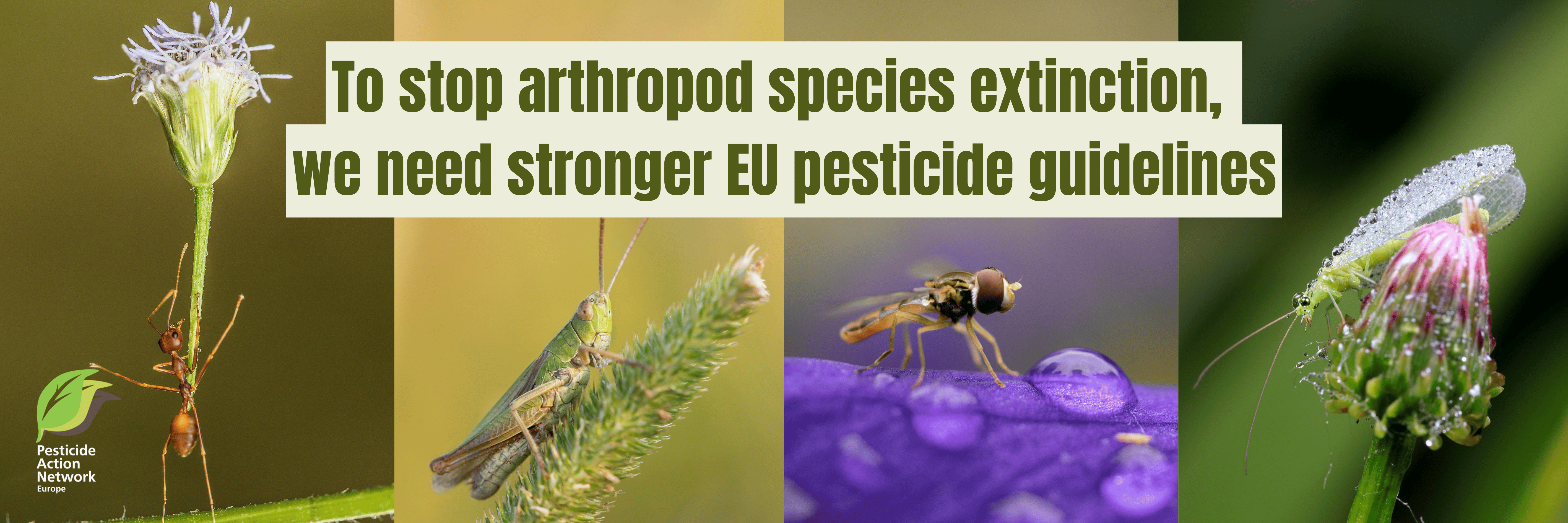
Arthropods — bees, beetles, butterflies, millipedes, spiders and many more — make up over 80% of all known animal species. Often misunderstood as mere “pests,” these small creatures are vital to life on Earth. They pollinate crops, keep soils healthy and rich, regulate pests, and sustain the very ecosystems we depend on. Yet, they are eradicated by so-called ‘crop protection’’. Industrial agriculture and widespread pesticide use have driven a catastrophic decline in their populations. Over the past 25 years, flying insect biomass has dropped by 75% in Europe. Even insects in nature protection areas are affected. Why does the EU Law fail to protect them?
The EU pesticide law is meant to protect health and the environment. But in practice, it does not. Why? We expose critical flaws in the EU’s pesticide risk assessment system, which has failed to safeguard these essential species. For over two decades, an industry-influenced guideline on ‘non-target arthropods’ has allowed the approval of harmful pesticides that play a major role in the decline of species we are currently witnessing. Finally, in 2025 the EU embarks on revising this outdated protocol, but our investigative report Licence to Kill reveals a biased approach that prioritises agricultural output over the protection of biodiversity. This is not in line with EU law.
Guidelines that fail to protect arthropods
In the current EU guideline, very biased concepts help to allow dangerous pesticides on the market. In fact, no pesticide has been banned because it is a threat to ‘non-target arthropods’.
- The authorities only look at individual pesticides. Not at the very harmful mix or cocktail of pesticides that arthropods are exposed to on a daily basis.
- The authorities only look at lethal effects. They don’t consider many other debilitating effects that disturb reproduction or disorient colonies.
- Tests are done on a very limited number of species and the pesticide producer can choose which one suits them best.
- The guidelines allow 50% mortality in one spraying. ‘They will recover’. But many species, especially the non-pests, don’t. No scientific research supports this concept.
- The guidelines use the ‘recovery’ concept. Even if 100% of the population are killed ‘they will come back’. In reality, they won’t, because many are not so mobile and the neighbouring fields are sprayed too. No scientific research supports this concept.
Concepts and guideline not in line with EU Law
On two recent occasions, the EU Court of Justice has made it clear that the EU law prescribes that protection of health and environment should prevail over plant cultivation.
“In this regard (...) the Court has already ruled that the authorisation rules for the placing of plant protection products on the market must ensure a high level of protection and that when such authorisations are granted, the protection of human and animal health and of the environment "must take precedence" over the improvement of plant cultivation (judgment of 19 January 2023, Pesticide Action Network Europe and Others, C-162/21, EU:C:2023:30, paragraph 48 and case-law cited there). (consideration 90) [1]
We urge EFSA and the European Commission to create a new guidance document which makes no compromise on protecting non-target arthropods from pesticides. Their survival is a matter of preventing the collapse of our entire ecosystems and our agriculture.
Read more:
- Licence to Kill - an EU guideline with far-reaching consequences, PAN Europe, November 2024
- Arthropod of the Month series (starting soon!)
- Interviews with leading scientists (starting soon!)
- The EU guideline that allows to kill most insects, PAN Europe, February 2024
- Pesticide Paradise: How industry and officials protected the most toxic pesticides, PAN Europe, September 2022
Notes:
[1] EU Court: member states do not properly carry out pesticide assessments